Decadal Changes in Greenland Ice Sheet Firn Aquifers from Radar Scatterometer
Abstract
:1. Introduction
2. Materials and Methods
2.1. Data
2.1.1. Enhanced-Resolution Radar Scatterometer Data
2.1.2. OIB Airborne Radar Observation
2.2. Methods
2.2.1. Selection of Input Vectors
2.2.2. Random Forests Classification Algorithm
3. Results
4. Discussion
4.1. Comparisons and Uncertainties
4.2. FAs in the Flade Isblink Ice Cap
4.3. FAs Anomalies in the Eastern of the GrIS
5. Conclusions
Author Contributions
Funding
Acknowledgments
Conflicts of Interest
References
- Zwally, H.J.; Abdalati, W.; Herring, T.; Larson, K.; Saba, J.; Steffen, K. Surface Melt-Induced Acceleration of Greenland Ice-Sheet Flow. Science 2002, 297, 218–222. [Google Scholar] [CrossRef] [PubMed]
- Dowdeswell, J.A. The Greenland Ice Sheet and Global Sea-Level Rise. Science 2006, 311, 963–964. [Google Scholar] [CrossRef] [PubMed]
- Hanna, E.; Navarro, F.J.; Pattyn, F.; Domingues, C.M.; Fettweis, X.; Ivins, E.R.; Nicholls, R.J.; Ritz, C.; Smith, B.; Tulaczyk, S.; et al. Ice-sheet mass balance and climate change. Nature 2013, 498, 51–59. [Google Scholar] [CrossRef]
- Van den Broeke, M.; Bamber, J.; Ettema, J.; Rignot, E.; Schrama, E.; van de Berg, W.J.; van Meijgaard, E.; Velicogna, I.; Wouters, B. Partitioning Recent Greenland Mass Loss. Science 2009, 326, 984–986. [Google Scholar] [CrossRef] [PubMed] [Green Version]
- van de Wal, R.S.W.; Boot, W.; van de Broeke, M.R.; Smeets, C.J.P.P.; Reijmer, C.H.; Donker, J.J.A.; Oerlemans, J. Large and Rapid Melt-Induced Velocity Changes in the Ablation Zone of the Greenland Ice Sheet. Science 2008, 321, 111–113. [Google Scholar] [CrossRef] [PubMed]
- Shannon, S.R.; Payne, A.J.; Bartholomew, I.D.; van de Broeke, M.R.; Edwards, T.L.; Fettweis, X.; Gagliardini, O.; Gillet-Chaulet, F.; Goelzer, H.; Hoffman, M.J.; et al. Enhanced basal lubrication and the contribution of the Greenland ice sheet to future sea-level rise. Proc. Natl. Acad. Sci. USA 2013, 110, 14156–14161. [Google Scholar] [CrossRef] [Green Version]
- Schoof, C. Ice-sheet acceleration driven by melt supply variability. Nature 2010, 468, 803–806. [Google Scholar] [CrossRef]
- Sundal, A.V.; Shepherd, A.; Nienow, P.; Hanna, E.; Palmer, S.; Huybrechts, P. Melt-induced speed-up of Greenland ice sheet offset by efficient subglacial drainage. Nature 2011, 469, 521–524. [Google Scholar] [CrossRef]
- van de Broeke, M.R.; Enderlin, E.M.; Howat, I.M.; Munneke, P.K.; Noël, B.P.Y.; van de Berg, W.J.; van Meijgaard, E.; Wouters, B. On the recent contribution of the Greenland ice sheet to sea level change. Cryosphere 2016, 10, 1933–1946. [Google Scholar] [CrossRef] [Green Version]
- Andrew, S.; Erik, I.; Eric, R.; Ben, S.; van den Broeke, M.; Isabella, V.; Pippa, W.; Kate, B.; Ian, J.; Gerhard, K.; et al. Mass balance of the Greenland Ice Sheet from 1992 to 2018. Nature 2020, 579, 233–239. [Google Scholar] [CrossRef]
- Dunmire, D.; Banwell, A.F.; Wever, N.; Lenaerts, J.T.M.; Datta, R.T. Contrasting regional variability of buried meltwater extent over 2 years across the Greenland Ice Sheet. Cryosphere 2021, 15, 2983–3005. [Google Scholar] [CrossRef]
- Houtz, D.; Mätzler, C.; Naderpour, R.; Schwank, M.; Steffen, K. Quantifying Surface Melt and Liquid Water on the Greenland Ice Sheet using L-band Radiometry. Remote Sens. Environ. 2021, 256, 112341. [Google Scholar] [CrossRef]
- Pitcher, L.H.; Smith, L.C.; Gleason, C.J.; Miège, C.; Ryan, J.C.; Hagedorn, B.; van As, D.; Chu, W.; Forster, R.R. Direct Observation of Winter Meltwater Drainage from the Greenland Ice Sheet. Geophys. Res. Lett. 2020, 47, e2019GL086521. [Google Scholar] [CrossRef] [Green Version]
- Forster, R.R.; Box, J.E.; Van Den Broeke, M.R.; Miège, C.; Burgess, E.W.; Van Angelen, J.H.; Lenaerts, J.T.M.; Koenig, L.S.; Paden, J.; Lewis, C.; et al. Extensive liquid meltwater storage in firn within the Greenland ice sheet. Nat. Geosci. 2014, 7, 95–98. [Google Scholar] [CrossRef]
- Montgomery, L.; Miège, C.; Miller, J.; Scambos, T.A.; Wallin, B.; Miller, O.; Solomon, D.K.; Forster, R.; Koenig, L. Hydrologic Properties of a Highly Permeable Firn Aquifer in the Wilkins Ice Shelf, Antarctica. Geophys. Res. Lett. 2020, 47, e2020GL089552. [Google Scholar] [CrossRef]
- van Wessem, J.M.; Steger, C.R.; Wever, N.; Van Den Broeke, M.R. An exploratory modelling study of perennial firn aquifers in the Antarctic Peninsula for the period 1979–2016. Cryosphere 2021, 15, 695–714. [Google Scholar] [CrossRef]
- Munneke, P.K.; Ligtenberg, S.R.M.; Van Den Broeke, M.R.; van Angelen, J.H.; Forster, R.R. Explaining the presence of perennial liquid water bodies in the firn of the Greenland Ice Sheet. Geophys. Res. Lett. 2014, 41, 476–483. [Google Scholar] [CrossRef] [Green Version]
- Miller, O.; Solomon, D.K.; Miège, C.; Koenig, L.; Forster, R.; Schmerr, N.; Ligtenberg, S.R.M.; Legchenko, A.; Voss, C.I.; Montgomery, L.; et al. Hydrology of a Perennial Firn Aquifer in Southeast Greenland: An Overview Driven by Field Data. Water Resour. Res. 2020, 56, e2019WR026348. [Google Scholar] [CrossRef]
- Harper, J.; Humphrey, N.; Pfeffer, W.T.; Brown, J.; Fettweis, X. Greenland ice-sheet contribution to sea-level rise buffered by meltwater storage in firn. Nature 2012, 491, 240–243. [Google Scholar] [CrossRef]
- Nienow, P.W.; Sole, A.J.; Slater, D.A.; Cowton, T.R. Recent Advances in Our Understanding of the Role of Meltwater in the Greenland Ice Sheet System. Curr. Clim. Chang. Rep. 2017, 3, 330–344. [Google Scholar] [CrossRef] [Green Version]
- Poinar, K.; Joughin, I.; Lilien, D.; Brucker, L.; Kehrl, L.; Nowicki, S. Drainage of Southeast Greenland Firn Aquifer Water through Crevasses to the Bed. Front. Earth Sci. 2017, 5, 5. [Google Scholar] [CrossRef] [Green Version]
- Koenig, L.S.; Miège, C.; Forster, R.R.; Brucker, L. Initial in situ measurements of perennial meltwater storage in the Greenland firn aquifer. Geophys. Res. Lett. 2014, 41, 81–85. [Google Scholar] [CrossRef] [Green Version]
- Christianson, K.; Kohler, J.; Alley, R.B.; Nuth, C.; van Pelt, W.J.J. Dynamic perennial firn aquifer on an Arctic glacier. Geophys. Res. Lett. 2015, 42, 1418–1426. [Google Scholar] [CrossRef]
- Machguth, H.; MacFerrin, M.; van As, D.; Box, J.E.; Charalampidis, C.; Colgan, W.; Fausto, R.S.; Meijer, H.A.J.; Mosley-Thompson, E.; Van De Wal, R.S.W. Greenland meltwater storage in firn limited by near-surface ice formation. Nat. Clim. Chang. 2016, 6, 390–393. [Google Scholar] [CrossRef] [Green Version]
- Miller, O.; Solomon, D.K.; Miège, C.; Koenig, L.; Forster, R.; Schmerr, N.; Ligtenberg, S.R.M.; Montgomery, L. Direct Evidence of Meltwater Flow within a Firn Aquifer in Southeast Greenland. Geophys. Res. Lett. 2018, 45, 207–215. [Google Scholar] [CrossRef] [Green Version]
- Killingbeck, S.F.; Schmerr, N.C.; Montgomery, L.N.; Booth, A.D.; Livermore, P.W.; Guandique, J.; Miller, O.L.; Burdick, S.; Forster, R.R.; Koenig, L.S.; et al. Integrated Borehole, Radar, and Seismic Velocity Analysis Reveals Dynamic Spatial Variations within a Firn Aquifer in Southeast Greenland. Geophys. Res. Lett. 2020, 47, e2020GL089335. [Google Scholar] [CrossRef]
- Montgomery, L.N.; Schmerr, N.; Burdick, S.; Forster, R.R.; Koenig, L.; Legchenko, A.; Ligtenberg, S.; Miège, C.; Miller, O.L.; Solomon, D.K. Investigation of Firn Aquifer Structure in Southeastern Greenland Using Active Source Seismology. Front. Earth Sci. 2017, 5, 10. [Google Scholar] [CrossRef] [Green Version]
- Killingbeck, S.; Schmerr, N.; Montgomery, L.; Booth, A.; Livermore, P.; Guandique, J.; Miller, O.; Burdick, S.; Forster, R.; Koenig, L.; et al. Deriving water content from multiple geophysical properties of a firn aquifer in southeast Greenland. In Proceedings of the EGU General Assembly 2020, Online, 4–8 May 2020. [Google Scholar] [CrossRef]
- Miège, C.; Forster, R.R.; Brucker, L.; Koenig, L.S.; Solomon, D.K.; Paden, J.D.; Box, J.E.; Burgess, E.W.; Miller, J.Z.; McNerney, L.; et al. Spatial extent and temporal variability of Greenland firn aquifers detected by ground and airborne radars. J. Geophys. Res. Earth Surf. 2016, 121, 2381–2398. [Google Scholar] [CrossRef]
- Chu, W.; Schroeder, D.M.; Siegfried, M.R. Retrieval of Englacial Firn Aquifer Thickness from Ice-Penetrating Radar Sounding in Southeastern Greenland. Geophys. Res. Lett. 2018, 45, 11,770–11,778. [Google Scholar] [CrossRef]
- Brangers, I.; Lievens, H.; Miège, C.; Demuzere, M.; Brucker, L.; De Lannoy, G.J.M. Sentinel-1 Detects Firn Aquifers in the Greenland Ice Sheet. Geophys. Res. Lett. 2020, 47, e2019GL085192. [Google Scholar] [CrossRef] [Green Version]
- Miller, J.Z.; Long, D.G.; Jezek, K.C.; Johnson, J.T.; Brodzik, M.J.; Shuman, C.A.; Koenig, L.S.; Scambos, T.A. Brief communication: Mapping Greenland’s perennial firn aquifers using enhanced-resolution L-band brightness temperature image time series. Cryosphere 2020, 14, 2809–2817. [Google Scholar] [CrossRef]
- Miller, J.Z.; Culberg, R.; Long, D.G.; Shuman, C.A.; Schroeder, D.M.; Brodzik, M.J. An empirical algorithm to map perennial firn aquifers and ice slabs within the Greenland Ice Sheet using satellite L-band microwave radiometry. Cryosphere 2022, 16, 103–125. [Google Scholar] [CrossRef]
- Samimi, S.; Marshall, S.J.; Vandecrux, B.; MacFerrin, M. Time-Domain Reflectometry Measurements and Modeling of Firn Meltwater Infiltration at DYE-2, Greenland. J. Geophys. Res. Earth Surf. 2021, 126, e2021JF006295. [Google Scholar] [CrossRef]
- Figa-Saldaña, J.; Wilson, J.J.W.; Attema, E.; Gelsthorpe, R.; Drinkwater, M.R.; Stoffelen, A. The advanced scatterometer (ASCAT) on the meteorological operational (MetOp) platform: A follow on for European wind scatterometers. Can. J. Remote Sens. 2002, 28, 404–412. [Google Scholar] [CrossRef]
- Long, D.G. Polar Applications of Spaceborne Scatterometers. IEEE J. Sel. Top. Appl. Earth Obs. Remote Sens. 2017, 10, 2307–2320. [Google Scholar] [CrossRef] [Green Version]
- Lindsley, R.D.; Long, D.G. Enhanced-Resolution Reconstruction of ASCAT Backscatter Measurements. IEEE Trans. Geosci. Remote Sens. 2016, 54, 2589–2601. [Google Scholar] [CrossRef]
- Long, D.G.; Hardin, P.J.; Whiting, P.T. Resolution enhancement of spaceborne scatterometer data. IEEE Trans. Geosci. Remote Sens. 1993, 31, 700–715. [Google Scholar] [CrossRef] [Green Version]
- Early, D.S.; Long, D.G. Image reconstruction and enhanced resolution imaging from irregular samples. IEEE Trans. Geosci. Remote Sens. 2001, 39, 291–302. [Google Scholar] [CrossRef] [Green Version]
- Miège, C. Spatial Extent of Greenland Firn Aquifer Detected by Airborne Radars, 2010–2017. Arctic Data Center. 2018. Available online: https://arcticdata.io/catalog/view/doi%3A10.18739%2FA2TM72225 (accessed on 20 June 2021).
- Rignot, E.; Mouginot, J. Ice flow in Greenland for the International Polar Year 2008–2009. Geophys. Res. Lett. 2012, 39, 11. [Google Scholar] [CrossRef] [Green Version]
- Rodriguez-Morales, F.; Gogineni, S.; Leuschen, C.J.; Paden, J.D.; Li, J.; Lewis, C.C.; Panzer, B.; Alvestegui, D.G.G.; Patel, A.; Byers, K.; et al. Advanced Multifrequency Radar Instrumentation for Polar Research. IEEE Trans. Geosci. Remote Sens. 2014, 52, 2824–2842. [Google Scholar] [CrossRef]
- Lewis, C.; Gogineni, S.; Rodriguez-Morales, F.; Panzer, B.; Stumpf, T.; Paden, J.; Leuschen, C. Airborne fine-resolution UHF radar: An approach to the study of englacial reflections, firn compaction and ice attenuation rates. J. Glaciol. 2015, 61, 89–100. [Google Scholar] [CrossRef] [Green Version]
- CReSIS. Accumulation Radar Data, Lawrence, KS, USA. Digital Media. 2021. Available online: https://data.cresis.ku.edu (accessed on 15 June 2021).
- CReSIS. Radar Depth Sounder Data, Lawrence, KS, USA. Digital Media. 2021. Available online: https://data.cresis.ku.edu (accessed on 15 June 2021).
- Ashcraft, I.S.; Long, D.G. Comparison of methods for melt detection over Greenland using active and passive microwave measurements. Int. J. Remote Sens. 2006, 27, 2469–2488. [Google Scholar] [CrossRef]
- Trusel, L.D.; Frey, K.E.; Das, S.B. Antarctic surface melting dynamics: Enhanced perspectives from radar scatterometer data. J. Geophys. Res. Earth Surf. 2012, 117, F02023. [Google Scholar] [CrossRef] [Green Version]
- Barrand, N.E.; Vaughan, D.G.; Steiner, N.; Tedesco, M.; Munneke, P.K.; van den Broeke, M.R.; Hosking, S. Trends in Antarctic Peninsula surface melting conditions from observations and regional climate modeling. J. Geophys. Res. Earth Surf. 2013, 118, 315–330. [Google Scholar] [CrossRef] [Green Version]
- Munneke, P.K.; Luckman, A.J.; Bevan, S.L.; Smeets, C.J.P.P.; Gilbert, E.; Broeke, M.R.V.D.; Wang, W.; Zender, C.; Hubbard, B.; Ashmore, D.; et al. Intense Winter Surface Melt on an Antarctic Ice Shelf. Geophys. Res. Lett. 2018, 45, 7615–7623. [Google Scholar] [CrossRef]
- Cao, B.; Zhang, T.; Peng, X.; Mu, C.; Wang, Q.; Zheng, L.; Wang, K.; Zhong, X. Thermal Characteristics and Recent Changes of Permafrost in the Upper Reaches of the Heihe River Basin, Western China. J. Geophys. Res. Atmos. 2018, 123, 7935–7949. [Google Scholar] [CrossRef]
- Zheng, L.; Zhou, C.; Liang, Q. Variations in Antarctic Peninsula snow liquid water during 1999–2017 revealed by merging radiometer, scatterometer and model estimations. Remote Sens. Environ. 2019, 232, 111219. [Google Scholar] [CrossRef]
- Bevan, S.L.; Luckman, A.J.; Munneke, P.K.; Hubbard, B.; Kulessa, B.; Ashmore, D.W. Decline in Surface Melt Duration on Larsen C Ice Shelf Revealed by the Advanced Scatterometer (ASCAT). Earth Space Sci. 2018, 5, 578–591. [Google Scholar] [CrossRef]
- Bevan, S.; Luckman, A.; Hendon, H.; Wang, G. The 2020 Larsen C Ice Shelf surface melt is a 40-year record high. Cryosphere 2020, 14, 3551–3564. [Google Scholar] [CrossRef]
- Banwell, A.F.; Datta, R.T.; Dell, R.L.; Moussavi, M.; Brucker, L.; Picard, G.; Shuman, C.A.; Stevens, L.A.; Datta, R.T.; Dell, R.L.; et al. The 32-year record-high surface melt in 2019/2020 on the northern George VI Ice Shelf, Antarctic Peninsula. Cryosphere 2021, 15, 909–925. [Google Scholar] [CrossRef]
- Smith, L.C.; Sheng, Y.; Forster, R.R.; Steffen, K.; Frey, K.E.; Alsdorf, D.E. Melting of small Arctic ice caps observed from ERS scatterometer time series. Geophys. Res. Lett. 2003, 30, 315–331. [Google Scholar] [CrossRef] [Green Version]
- Zwally, H.J.; Fiegles, S. Extent and duration of Antarctic surface melting. J. Glaciol. 1994, 40, 463–476. [Google Scholar] [CrossRef]
- Wismann, V. Monitoring of seasonal thawing in Siberia with ERS scatterometer data. IEEE Trans. Geosci. Remote Sens. 2000, 38, 1804–1809. [Google Scholar] [CrossRef]
- Wismann, V.; Winebrenner, D.P.; Boehnke, K.; Arthern, R.J. Snow accumulation on Greenland estimated from ERS scatterometer data. In Proceedings of the International Geoscience and Remote Sensing Symposium (IGARSS), Singapore, 3–8 August 1997; Volume 4, pp. 1823–1825. [Google Scholar]
- Drinkwater, M.R.; Long, D.G.; Bingham, A.W. Greenland snow accumulation estimates from satellite radar scatterometer data. J. Geophys. Res. Atmos. 2001, 106, 33935–33950. [Google Scholar] [CrossRef] [Green Version]
- Munk, J.; Jezek, K.C.; Forster, R.R.; Gogineni, S.P. An accumulation map for the Greenland dry-snow facies derived from spaceborne radar. J. Geophys. Res. Atmos. 2003, 108, 4280. [Google Scholar] [CrossRef]
- Nghiem, S.V.; Steffen, K.; Neumann, G.; Huff, R. Mapping of ice layer extent and snow accumulation in the percolation zone of the Greenland ice sheet. J. Geophys. Res. Earth Surf. 2005, 110, F02017. [Google Scholar] [CrossRef] [Green Version]
- Morlighem, M.; Williams, C.N.; Rignot, E.; An, L.; Arndt, J.E.; Bamber, J.L.; Catania, G.; Chauché, N.; Dowdeswell, J.A.; Dorschel, B.; et al. BedMachine v3: Complete Bed Topography and Ocean Bathymetry Mapping of Greenland from Multibeam Echo Sounding Combined with Mass Conservation. Geophys. Res. Lett. 2017, 44, 11,051–11,061. [Google Scholar] [CrossRef] [Green Version]
- Stumpf, A.; Kerle, N. Object-oriented mapping of landslides using Random Forests. Remote Sens. Environ. 2011, 115, 2564–2577. [Google Scholar] [CrossRef]
- Feng, Q.; Liu, J.; Gong, J. UAV Remote Sensing for Urban Vegetation Mapping Using Random Forest and Texture Analysis. Remote Sens. 2015, 7, 1074–1094. [Google Scholar] [CrossRef] [Green Version]
- Breiman, L. Random forests. Mach. Learn. 2001, 45, 5–32. [Google Scholar] [CrossRef] [Green Version]
- Catani, F.; Lagomarsino, D.; Segoni, S.; Tofani, V. Landslide susceptibility estimation by random forests technique: Sensitivity and scaling issues. Nat. Hazards Earth Syst. Sci. 2013, 13, 2815–2831. [Google Scholar] [CrossRef] [Green Version]
- Cracknell, M.J.; Reading, A.M. Geological mapping using remote sensing data: A comparison of five machine learning algorithms, their response to variations in the spatial distribution of training data and the use of explicit spatial information. Comput. Geosci. 2014, 63, 22–33. [Google Scholar] [CrossRef] [Green Version]
- Li, C.; Wang, J.; Wang, L.; Hu, L.; Gong, P. Comparison of Classification Algorithms and Training Sample Sizes in Urban Land Classification with Landsat Thematic Mapper Imagery. Remote Sens. 2014, 6, 964–983. [Google Scholar] [CrossRef] [Green Version]
- Belgiu, M.; Csillik, O. Sentinel-2 cropland mapping using pixel-based and object-based time-weighted dynamic time warping analysis. Remote Sens. Environ. 2018, 204, 509–523. [Google Scholar] [CrossRef]
- Maxwell, A.E.; Warner, T.A.; Fang, F. Implementation of machine-learning classification in remote sensing: An applied review. Int. J. Remote Sens. 2018, 39, 2784–2817. [Google Scholar] [CrossRef] [Green Version]
- Haran, T.; Bohlander, J.; Scambos, T.; Painter, T.; Fahnestock, M. MEaSUREs MODIS Mosaic of Greenland (MOG) 2005, 2010, and 2015 Image Maps, Version 2. 2018. Available online: https://nsidc.org/data/nsidc-0547/versions/2 (accessed on 10 October 2021).
- Zebker, H.; Hoen, E.W. Penetration depths inferred from interferometric volume decorrelation observed over the Greenland Ice Sheet. IEEE Trans. Geosci. Remote Sens. 2000, 38, 2571–2583. [Google Scholar] [CrossRef]
- Zheng, L.; Zhou, C.; Wang, K. Enhanced winter snowmelt in the Antarctic Peninsula: Automatic snowmelt identification from radar scatterometer. Remote Sens. Environ. 2020, 246, 111835. [Google Scholar] [CrossRef]
- MacFerrin, M.; Machguth, H.; Van As, D.; Charalampidis, C.; Stevens, C.M.; Heilig, A.; Vandecrux, B.; Langen, P.L.; Mottram, R.; Fettweis, X.; et al. Rapid expansion of Greenland’S low-permeability ice slabs. Nature 2019, 573, 403–407. [Google Scholar] [CrossRef]
- Hersbach, H.; Bell, B.; Berrisford, P.; Biavati, G.; Horányi, A.; Muñoz Sabater, J.; Nicolas, J.; Peubey, C.; Radu, R.; Rozum, I.; et al. ERA5 monthly averaged data on single levels from 1979 to present 2019. Copernic. Clim. Change Serv. C3S Clim. Data Store CDS 2019, 10, 252–266. [Google Scholar]
- Montgomery, L.; Koenig, L.; Lenaerts, J.T.M.; Munneke, P.K. Accumulation rates (2009–2017) in Southeast Greenland derived from airborne snow radar and comparison with regional climate models. Ann. Glaciol. 2020, 61, 225–233. [Google Scholar] [CrossRef] [Green Version]
- Steger, C.R.; Reijmer, C.H.; van den Broeke, M.R.; Wever, N.; Forster, R.R.; Koenig, L.S.; Munneke, P.K.; Lehning, M.; Lhermitte, S.; Ligtenberg, S.R.M.M.; et al. Firn Meltwater Retention on the Greenland Ice Sheet: A Model Comparison. Front. Earth Sci. 2017, 5, 3. [Google Scholar] [CrossRef] [Green Version]
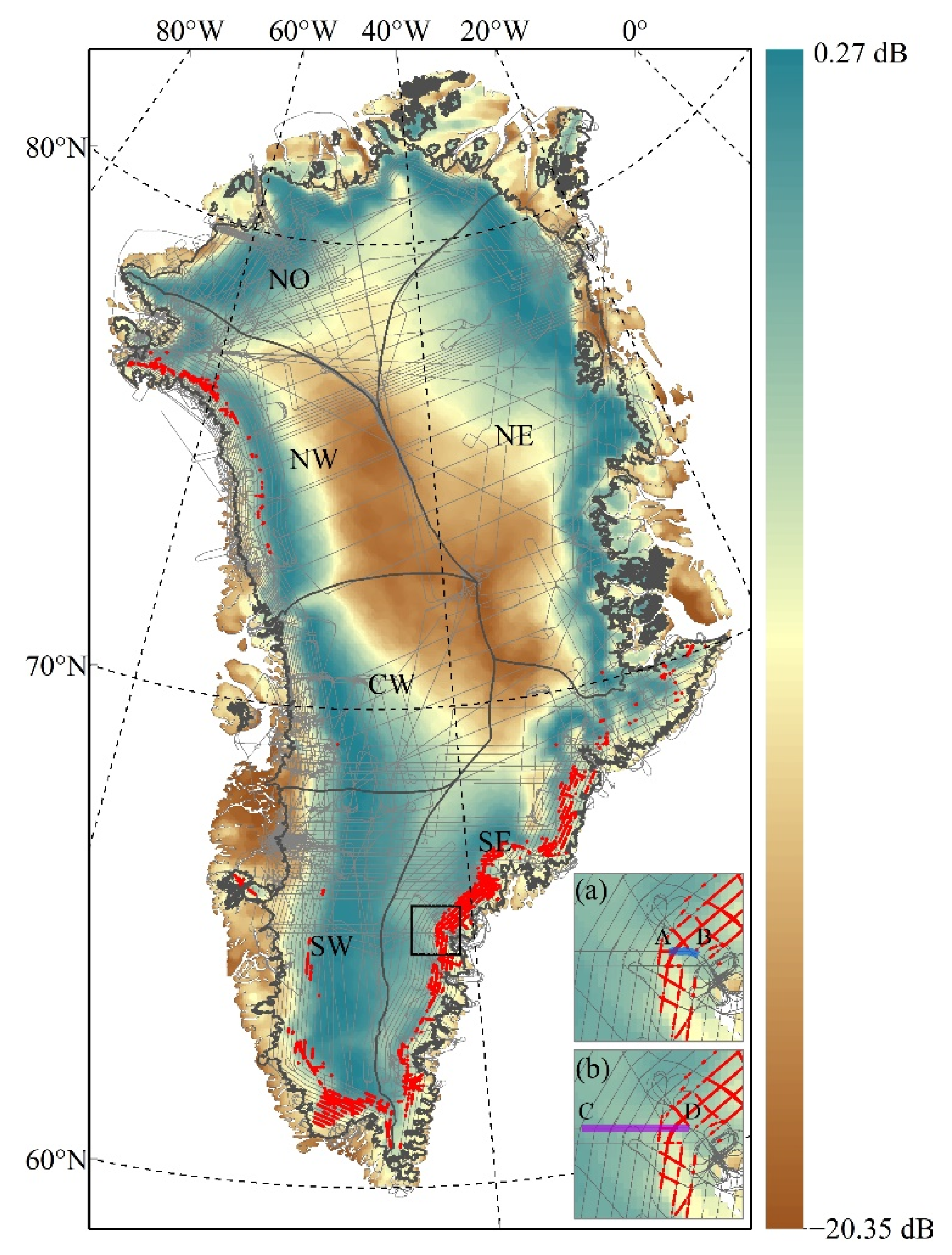
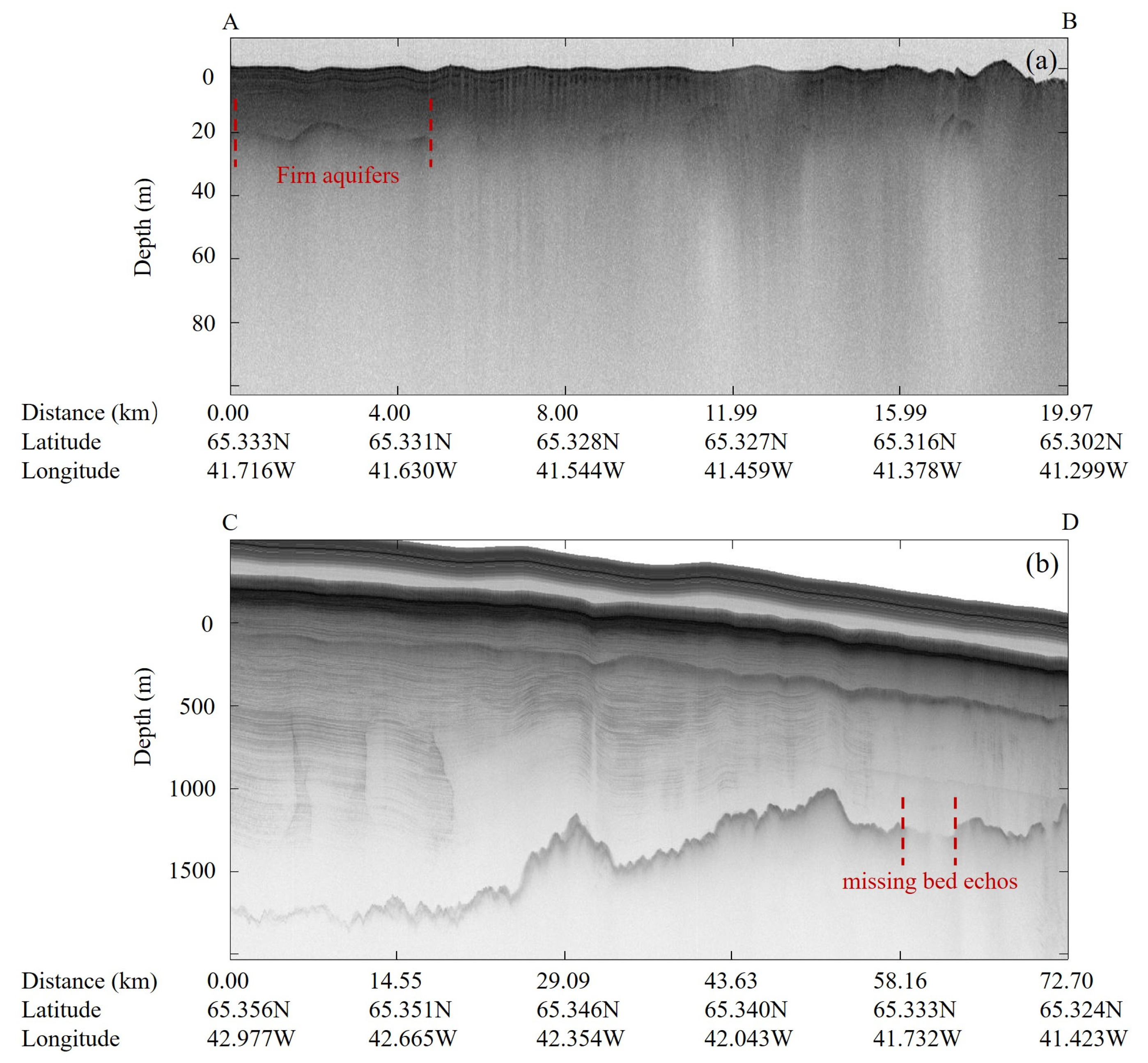
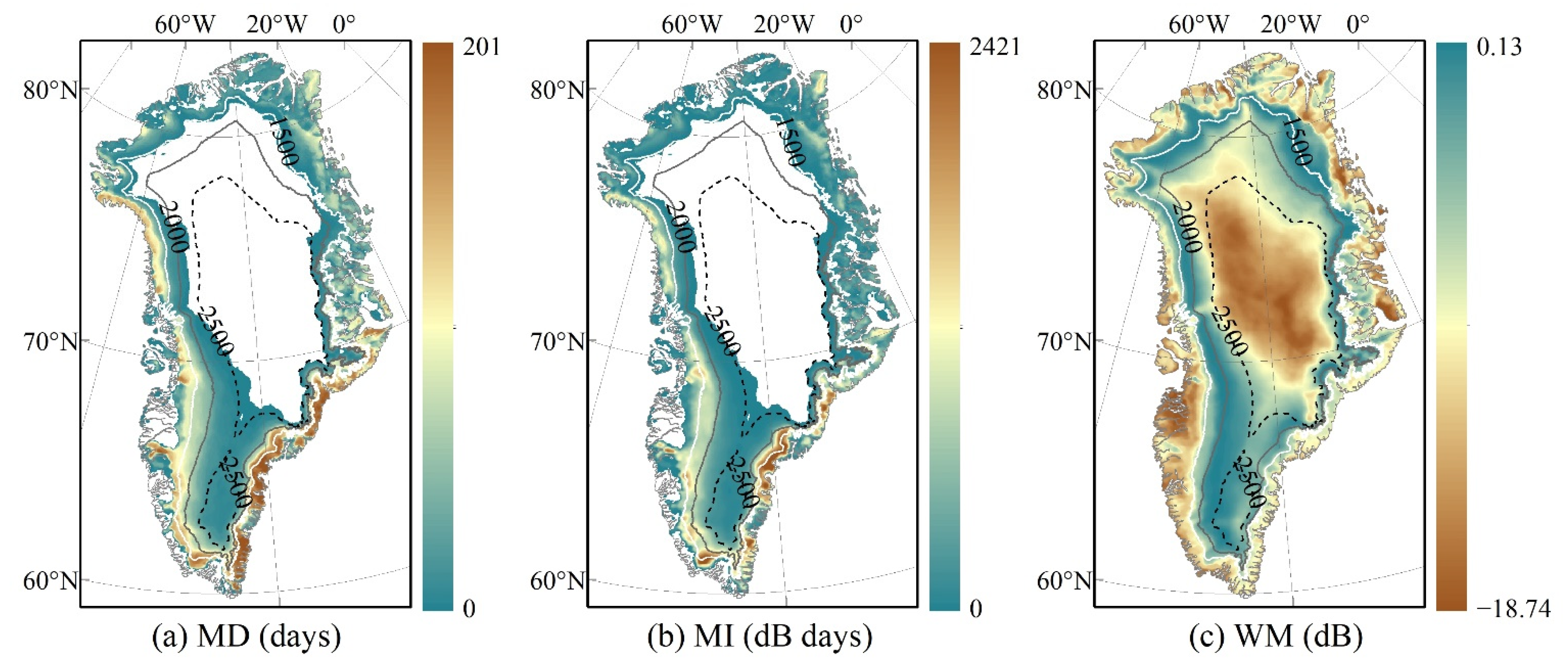
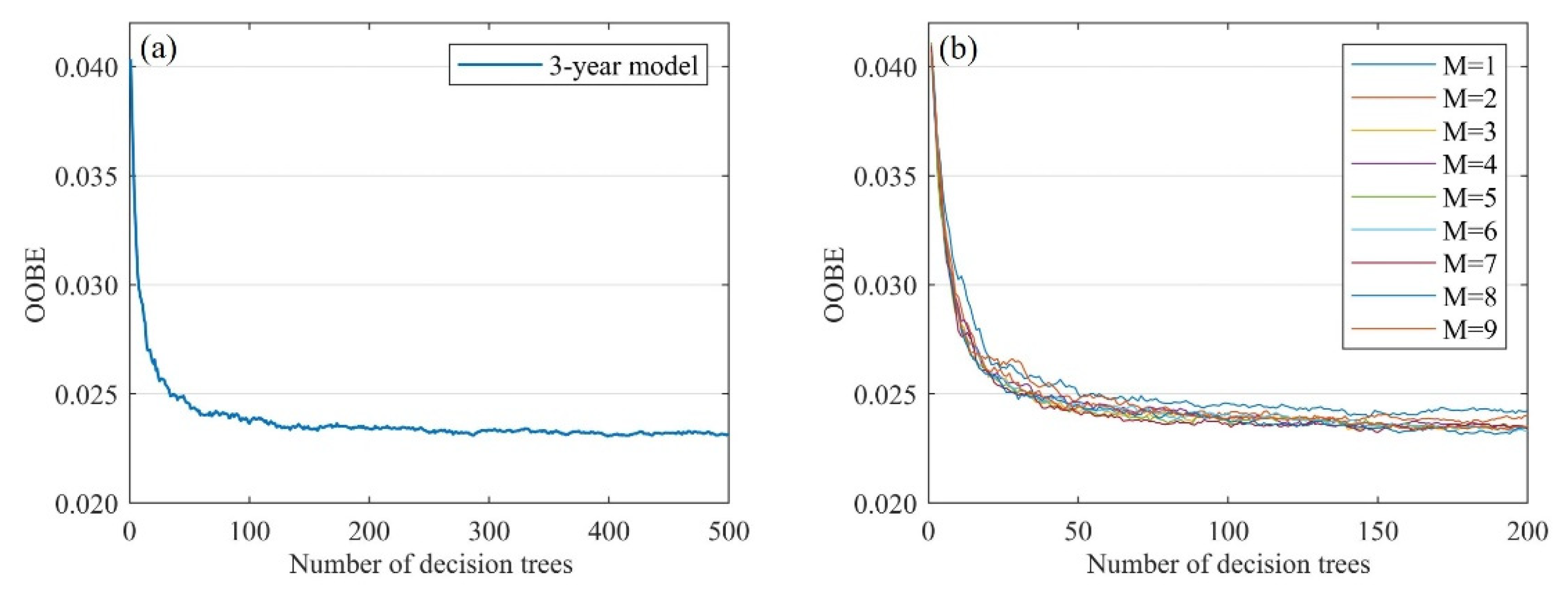


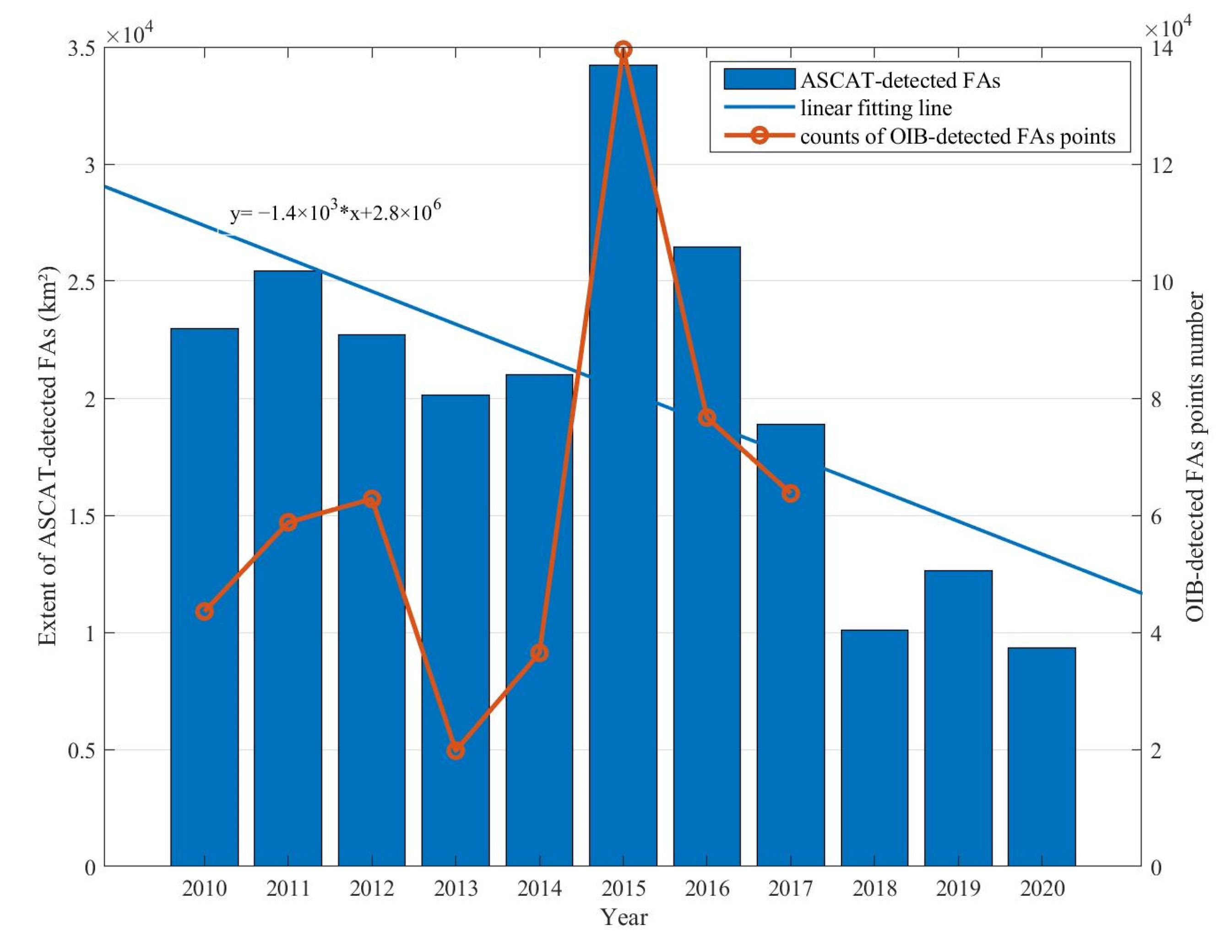
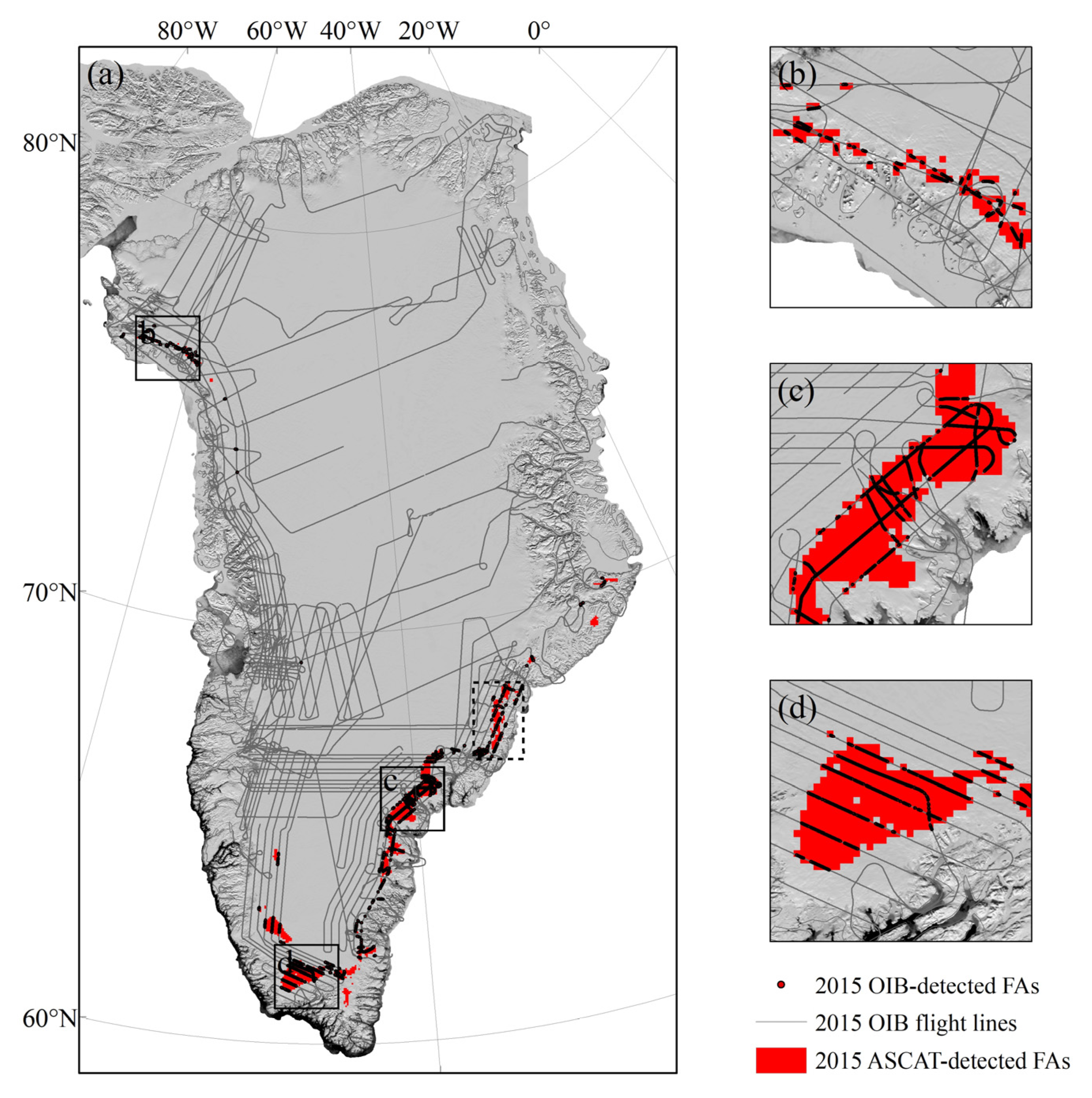
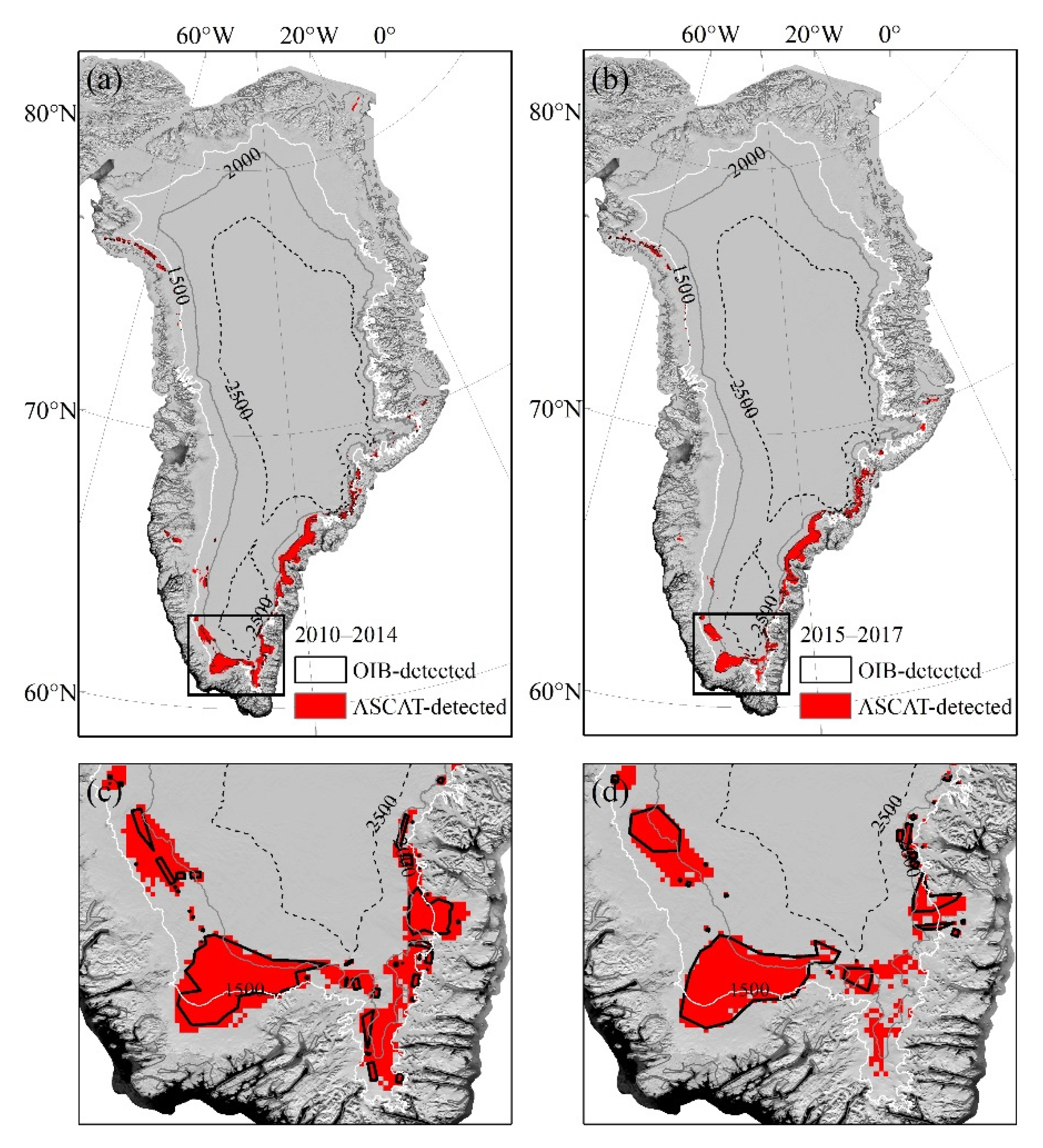
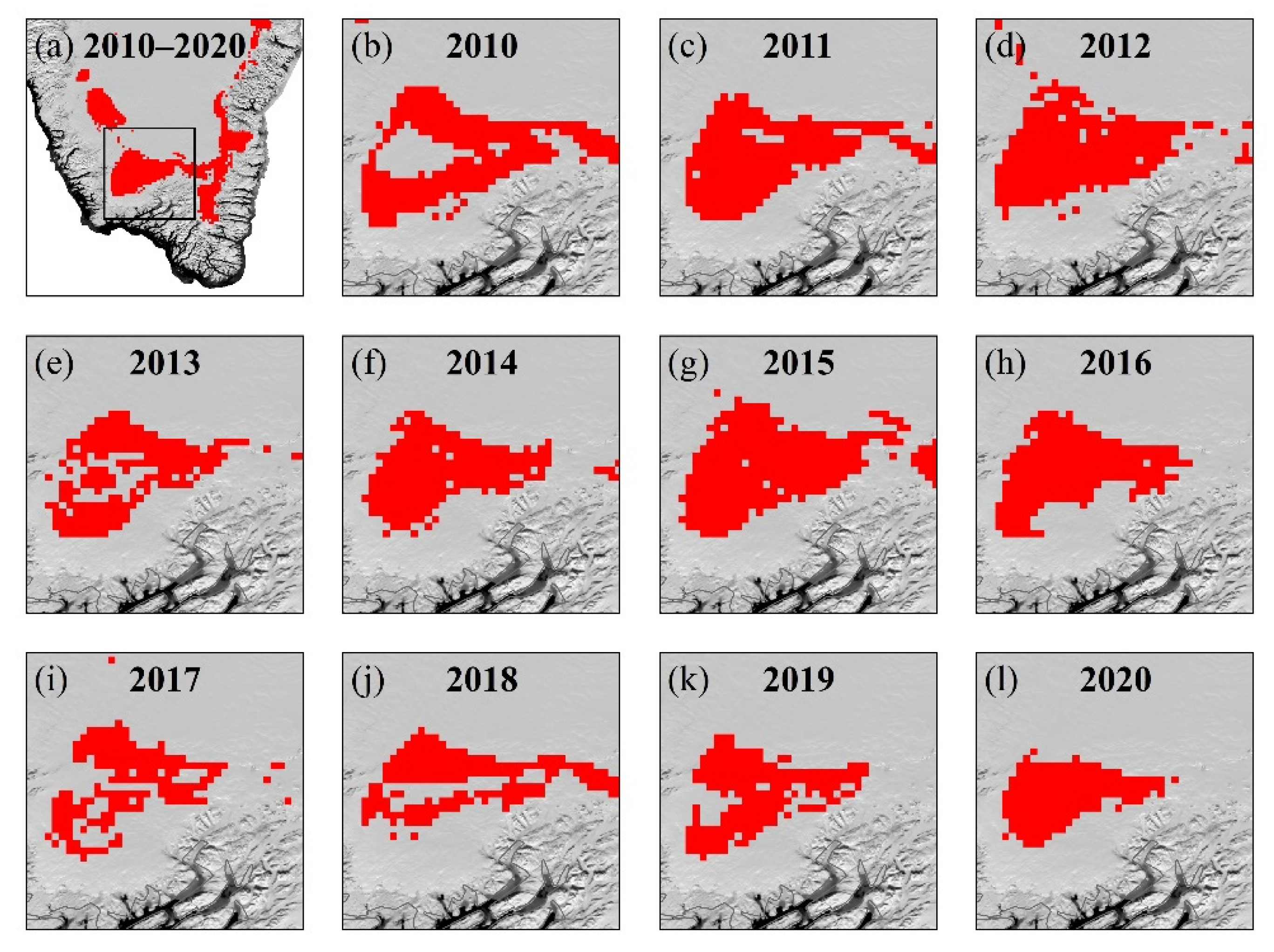
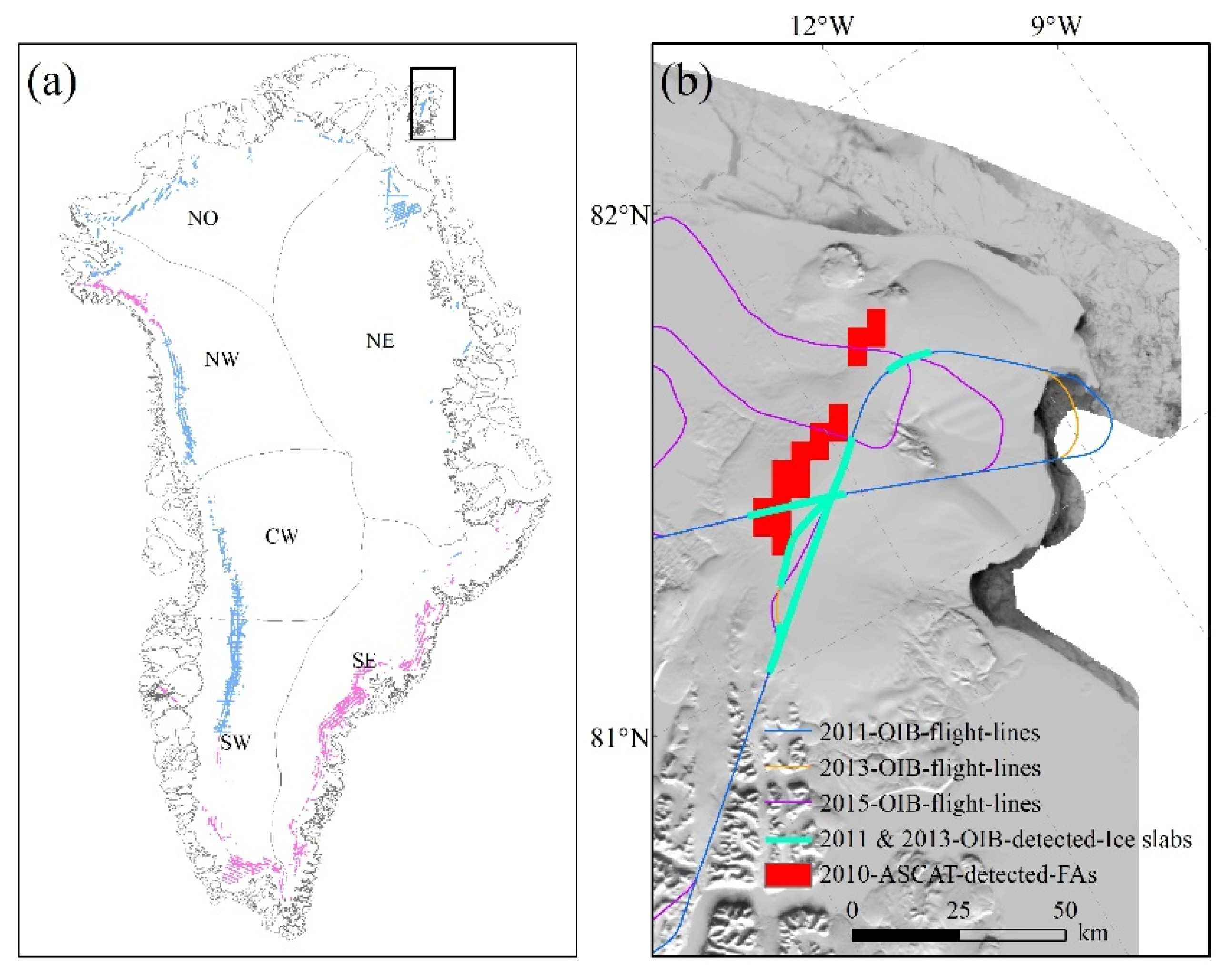
| Number of Grids | |||
|---|---|---|---|
| Year | FAs | NFAs | Total |
| 2010 | 252 | 4765 | 5017 |
| 2011 | 412 | 10,687 | 11,099 |
| 2012 | 491 | 12,309 | 12,800 |
| 2013 | 188 | 8698 | 8886 |
| 2014 | 291 | 8756 | 9047 |
| 2015 | 785 | 10,494 | 11,279 |
| 2016 | 463 | 5011 | 5474 |
| 2017 | 426 | 12,656 | 13,082 |
| Total | 3308 | 73,376 | 76,684 |
| Model | Kappa | OA(%) | TN | TP | FN | FP |
|---|---|---|---|---|---|---|
| 1-year | 0.56 | 96.20 | 3638 | 103 | 94 | 54 |
| 2-year | 0.68 | 97.15 | 3652 | 126 | 71 | 40 |
| 3-year | 0.72 | 97.49 | 3657 | 134 | 63 | 35 |
| 4-year | 0.72 | 97.57 | 3659 | 135 | 62 | 33 |
| 5-year | 0.73 | 97.60 | 3659 | 136 | 60 | 33 |
| 6-year | 0.74 | 97.63 | 3659 | 137 | 59 | 33 |
| 7-year * | 0.74 | 97.47 | 3659 | 138 | 59 | 33 |
| Year | OIB-Detected | ASCAT-Detected |
|---|---|---|
| Area/km2 | Area/km2 | |
| 2010 | - | 22,971 |
| 2011 | - | 25,446 |
| 2012 | - | 22,713 |
| 2013 | - | 20,139 |
| 2014 | - | 20,991 |
| 2015 | - | 34,219 |
| 2016 | - | 26,476 |
| 2017 | - | 18,872 |
| 2018 | - | 10,079 |
| 2019 | - | 12,634 |
| 2020 | - | 9347 |
| 2010–2020 | - | 56,477 |
| 2010–2014 | 22,947 | 45,526 |
| 2015–2017 | 22,858 | 42,179 |
Publisher’s Note: MDPI stays neutral with regard to jurisdictional claims in published maps and institutional affiliations. |
© 2022 by the authors. Licensee MDPI, Basel, Switzerland. This article is an open access article distributed under the terms and conditions of the Creative Commons Attribution (CC BY) license (https://creativecommons.org/licenses/by/4.0/).
Share and Cite
Shang, X.; Cheng, X.; Zheng, L.; Liang, Q.; Chi, Z. Decadal Changes in Greenland Ice Sheet Firn Aquifers from Radar Scatterometer. Remote Sens. 2022, 14, 2134. https://doi.org/10.3390/rs14092134
Shang X, Cheng X, Zheng L, Liang Q, Chi Z. Decadal Changes in Greenland Ice Sheet Firn Aquifers from Radar Scatterometer. Remote Sensing. 2022; 14(9):2134. https://doi.org/10.3390/rs14092134
Chicago/Turabian StyleShang, Xinyi, Xiao Cheng, Lei Zheng, Qi Liang, and Zhaohui Chi. 2022. "Decadal Changes in Greenland Ice Sheet Firn Aquifers from Radar Scatterometer" Remote Sensing 14, no. 9: 2134. https://doi.org/10.3390/rs14092134
APA StyleShang, X., Cheng, X., Zheng, L., Liang, Q., & Chi, Z. (2022). Decadal Changes in Greenland Ice Sheet Firn Aquifers from Radar Scatterometer. Remote Sensing, 14(9), 2134. https://doi.org/10.3390/rs14092134







